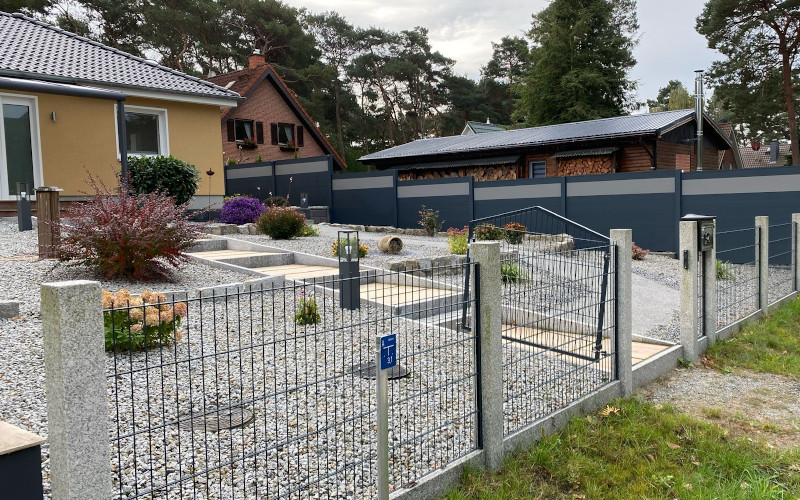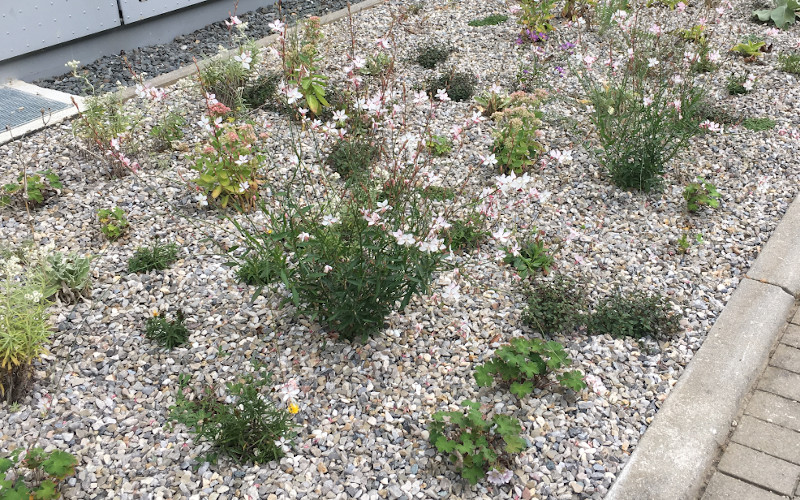The bdla Bavaria demands in a statement a demarcation of the rightly criticized gravel gardens from rock gardens, gravel mulch and gravelly soil substrates.

In July 2021, the Bavarian State Ministry of Housing, Construction and Transport issued a statement on the climate-sensitive handling of precipitation water in urban land use planning, in particular the determination of the floor area in relation to "rock gardens/gravel areas", in close technical coordination with the Bavarian State Ministry of the Environment and Consumer Protection, due to numerous enquiries from local authorities, planning offices and building supervisory authorities.
In response to the letter to lower building supervisory authorities, governments and municipal umbrella organizations, the bdla Bayern would like to advance the factual discussion with its statement:
Demarcation of so-called gravel gardens from rock gardens, gravel plantings, gravel mulch.
Gardens and in particular front gardens coin our cities and villages substantially. They form transition zones into the public space and influence the face of our residential areas, they contribute to the quality of life of all of us and accompany and enrich our daily walks. Using our current knowledge, one of our primary goals should be to design these gardens as high-quality and sustainable living spaces.
Gravel gardens are a design that has become fashionable in recent years among more and more homeowners, primarily for front gardens as an interpretation of a low-maintenance garden. Since these 'gravel gardens' are usually only very sparsely planted and result in ecologically worthless areas, many Bavarian municipalities have now issued bans against so-called gravel gardens, e.g. the city of Erlangen in February 2020 and Würzburg in July 2020. The state of Baden-Württemberg even issued a state-wide ban in August 2020.
In July 2021, the Bavarian State Ministry of Housing, Construction and Transport sent a letter to all municipalities in Bavaria pointing out that gravel or crushed stone surfaces - even in a seepage-capable design - will in future be classified as building structures within the meaning of Section 1 9 (2) and (4) BauNVO and must therefore be included in the GRZ. This is justified by the mostly very sparse planting, by the root protection foils preventing seepage against weed growth and by the heating effect of the gravel surfaces.
- Gravel gardens also contradict, in the view of the BDLA, all principles for sustainable, climate-friendly, biodiverse garden design and should be avoided for the following reasons:
- Areas that are covered exclusively with mineral gravel or pebbles without planting heat up themselves and the surrounding area very strongly. This effect increases the darker the cover material is.
- Covering sheets installed under the crushed stone to protect against weed growth prevent or impede rainwater seepage and destroy the build-up of natural soil fauna.
- The sparse (thus low-maintenance) planting typical of gravel gardens usually consists of a few evergreen, flowerless plants and is thus largely worthless for native fauna, especially birds, insects or (wild) bees.
Due to the lack of vegetation, there is no dust binding, no cooling effect through evaporation, no oxygen production or CO² binding.
A gravel garden is not a rock garden.
bdla Bavaria
A gravel garden is not a rock garden: What sounds like a play on words contains a very important distinction from the forbidden 'gravel gardens' to other elements of modern landscape architecture. From the point of view of the BDLA Bavaria, a clear distinction must be made between the criticized gravel gardens and classic (alpine) rock gardens, plantings in mineral gravel and gravel substrates and the covering of planting areas with mineral mulch blankets, especially with regard to their classification as structural installations.
According to Wikipedia, a gravel garden is defined as follows:
"A gravel garden is a garden area covered extensively with stones, in which the stones are the main design element. Plants do not occur or only in small numbers, if they do, then often artificially designed by strict topiary. Crushed stones with sharp edges and no curves are often used as stone material (crushed stone); however, rubble, gravel or chippings can also be used for the same style. The term is used to distinguish it from classic rock and gravel gardens, where vegetation is the main feature, and has been coined in this sense by studies, media and initiatives.
The main objective for the creation of gravel gardens is a garden area that is perceived as neat, with the simultaneous expectation of low maintenance."
At this point, the BDLA Bavaria would like to name the following elements of landscape architecture in particular, which are to be clearly differentiated from gravel gardens:
1. classical rock gardens
In classical rock gardens, the vegetation is in the foreground. Rock gardens are often modelled on alpine and sun-exposed dry sites. Rock gardens are planted with drought-tolerant grasses and perennials. The substrates are usually gravelly or gravelly, emaciated soils with a low humus content. Stones are mostly used for decoration or, in the case of dry stone walls, to overcome differences in height. While gravel gardens tend to be classified as hostile to life, rock gardens are intensively planted and are usually even suitable as a habitat for heat-loving animals such as lizards and insects. Ideally, rock gardens should be planted with regionally sourced stone material.
2. planting in gravel substrates
In recent years, many garden offices and universities have conducted very successful studies on planting perennials and grasses in mineral substrates of gravel and crushed stone. By planting suitable perennials and grasses that root through the gravelly subsoil substrates into the deeper soil layers, these plantings are much less sensitive to drought and thus more suitable for sun-exposed sites than pure topsoil plantings.
Even in heavily used perennial areas, such as schools, the success of growth is usually better in mineral substrates than in pure topsoil, which is much more compacted by foot traffic. There are also a large number of native ruderal plants such as mullein or chicory, which grow very well in mineral substrates and are important flowering and food plants for numerous insects. With a clever selection of species, flowering times can be achieved almost all year round.

3. covering of planting areas with gravel as mulch layer
To reduce drying and hardening of topsoil areas, perennial plantings are usually covered with bark mulch or woodchip mulch. On the one hand, this mulch layer reduces the growth of extraneous vegetation, ensures better absorption of rainwater and leads to less evaporation of the soil water stored in the top soil layer due to capillary breakage. However, bark mulch also has major disadvantages: Bark mulch usually rots within a few years, lowers the PH- value of the soil into a slightly acidic range and removes nitrogen from the soil.
Mineral mulch made of crushed stone or chippings does not have these disadvantages and provides lasting protection for perennials and grasses, which develop much better with a mineral mulch. With a mulch layer
of crushed stone or gravel, the soil dries out less, is protected from compaction and reduces weed growth. The installation of a fleece is not necessary and also only possible to a limited extent, as the areas are planted relatively densely with perennials. The goal of these plantings is to have the soil almost completely covered with the plants within a few years. Then the mulch layer is also only visible in places or temporarily during the winter months.
Perennial plantings in gravelly and gravelly substrates with a mineral mulch cover are increasingly being incorporated into traffic areas and seepage areas due to their durability, reduced maintenance requirements and high biodiversity value.
All 3 mentioned topics of garden design are indispensable elements in landscape architecture, which at first glance are very similar to gravel gardens.
Therefore, the BDLA Bavaria explicitly demands a differentiation of gravel gardens to rock gardens, gravel mulch and gravelly soil substrates.
25.09.2021, BDLA Bavaria
Board of Directors, AG KIima
- Latitude: 0
- Longitude: 0


